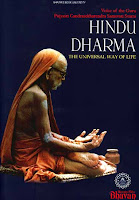Voice of the Guru - Chapter 1

“Deivathin Kural” or the “Voice of the God” is the collection of discourses originally delivered in Tamizh by our Kanchi Paramacharya, Mahaperiyava Sri Chandrasekerandra Saraswati brought out as a book in Tamizh by Sri Ra. Ganapathy. Our life time is not sufficient to read, understand and realize what our Paramacharya has advised. So far there are about seven volumes got published under the title ‘Deivathin Kural’. Though I have the first two volumes in Tamizh, I have not read completely and occasionally flip through some of the chapters. When I left my earlier organization my finance colleagues gifted me the first two volumes of Deivathin Kural translated into English by Sri R.G.K. who was the former Assistant Editor of the Illustrated Weekly of India and published by Bharathiya Vidya Bhavan. Even this book also I could not able to read for want of time, hence thought of publishing this regularly in my blog which will make me to read compulsorily before publishing. I am planning to

